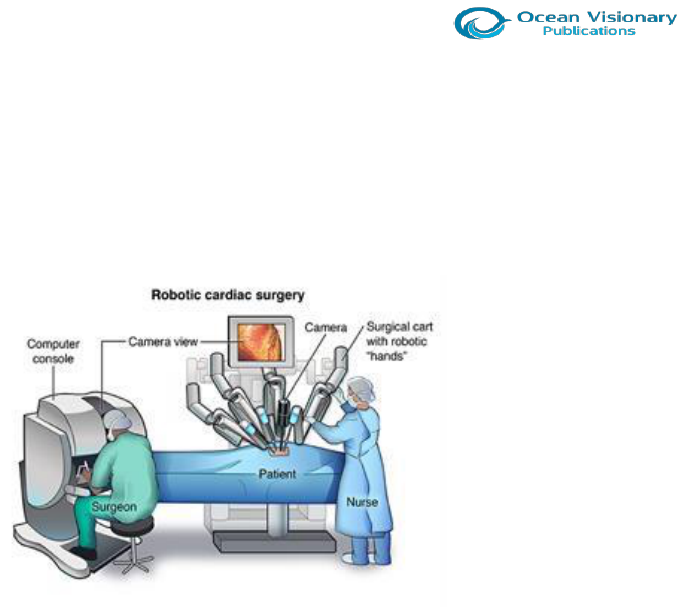
Ocean Journal of Engineering Studies and Research
Editorial Article
Ocean J of Engineering Studies & Research (OJESR), |Volume 1|Issue 1|
Medical Robots and its Applications
Manu Mitra
*
Alumnus with Electrical Engineering Department, University of Bridgeport, 126 Park Avenue, Bridgeport, CT -
06604, USA
ABSTRACT
Medical Robots are machines that are operated in medical sciences. There are few classifications for medical
robotics such as assistive robots, robots imitating human. Comparatively, medical robots offer wide range of
advantages, for example they are flexible and can be programmed to perform multiple tasks, they are more adaptable
and cost effective. Further, they eliminate human fatigue. A fully autonomous robot acquires and processes
information and performs specific physical action. Few medical robots are reviewed.
KEYWORDS: Medical; Medical Robots; Applications; Autonomous.
Citation: Manu Mitra. Medical Robots and its applications. Oce J Eng Stud Res. 2021;1(1):1-5.
Received Date: 22 September, 2021; Accepted Date: 9 October, 2021; Published Date: 13 October, 2021
*
Corresponding author: Manu Mitra, Alumnus with Electrical Engineering Department, University of Bridgeport,
126 Park Avenue, Bridgeport, CT – 06604, USA.
Copyright: © Manu Mitra, Open Access 2021. This article, published in Oce J Eng Stud Res (OJESR) (Attribution
4.0 International), as described by http:// creativecommons.org/licenses/by/4.0/.
_____________________________________________________________________________________________
INTRODUCTION
MEDICAL ROBOTIC HAND
Medical Robotic hand could allow physicians and surgeons to diagnose accurately and treat people. Scientist
designed medical robotic hand and a smart electronic skin capable of evaluating vital diagnostic data using an
advanced invention of rubbery semiconductor with high carrier mobility.
Associate professor of Mechanical Engineering at University of Houston and corresponding author for the work
concluded that semiconductor rubbery material can be effortlessly scaled for manufacturing based on the assembly
at the interface of water and air. Scientist confirmed that production is not that complicated. A commercially semi-
conductor material is liquefied in a solution and dropped in water, where it spreads, and the chemical solvent
evaporates form the solution which results in enhanced semi-conductor properties.
Interfacial assembly and the rubbery electronic devices suggest a pathway leading to soft, stretchy rubbery
electronics and integrated systems that imitates the mechanical softness of biological tissues that is suitable for a
variety of emerging applications.
[1,2]

Ocean Journal of Engineering Studies and Research
Editorial Article
Ocean J of Engineering Studies & Research (OJESR), |Volume 1|Issue 1|
MEDICAL ROBOTS HELP TO NAVIGATE EMERGENCY ROOMS
Figure 1: Illustrates Robot checking pulse of the patient.
[3]
Researchers created more precise navigation system which allows robots to navigate demanding clinical
environments in emergency and as well as general departments more specifically. Scientist also created an open
source datasets videos to assist and train robotic navigation.
Scientists at University of California, San Diego built a navigation system which is called Safety Critical Deep Q-
Network (Safe DQN) algorithm that takes into the system. It determines that how many individuals are clustered
together in a space and how quickly and abruptly these people are moving. This method was invented based on the
observations of clinicians conducted in the emergency department. When patient’s state worsens, team immediately
rucks around them to render aid. The navigation system guides the robots to move around these clustered groups of
people.
Scientists then tested their algorithm in a simulation environment and then compared its performance to other state
of art robotic navigation systems (Figure 1). The results for Safe DQN system generated were efficient and safe in
most of the cases. This algorithm can be also used outside of emergency department for an instance, search and
rescue missions.
[4]
ROBOTIC HEART VALVE SURGERY
Scientists and Researchers from New York University Medical Center declared the first minimally invasive robotic
heart valve surgery was completed successfully in United States. They used Robotic Surgical System to perform
minimally invasive mitral valve repair.
This robotic technology provides an operative field of view with ten to fifteen times magnification which is a
significant increase over the standard surgical loops which can only provide three to four times magnification.
This robot also has increased safety procedure by allowing the surgeon to control the endoscope and surgical
instruments in real time from the workstation instead of standing throughout long hours and complex procedure. The
system interface also has the capability to provide precise needle placement which is critical to the success of heart
surgery (Figure 2).

Ocean Journal of Engineering Studies and Research
Editorial Article
Ocean J of Engineering Studies & Research (OJESR), |Volume 1|Issue 1|
While seated at workstation few feet away from the patient, surgeon controls three robotic arms on the operating
table. While viewing a video monitor to view the operative site, surgeon manipulates conventional minimally
invasive device as robots replicates these movements with the instrument tips at the operative site. Surgeon also
have the capability to move endoscope using simple voice commands to directly control the visualization during a
procedure.
[5]
Figure 2: Illustrates Robotic Cardiac Surgery.
[6]
MAGNETIC MILLIROBOTS FOR MEDICAL TREATMENT
Researchers to advance minimally invasive medical treatments; they proposed tiny robots which is driven by
magnetic potential energy from Magnetic Resonance Imaging (MRI) scanners.
Assistant Professor of electrical and computer engineering at University of Houston confirmed that potential
technology can be used to treat hydrocephalus and other conditions allowing surgeons to avoid current treatments
that requires cutting through the skull to implant pressure relieving shunts. It entails a method for generating
significant impulsive forces that can be used to penetrate tissue – it is used to send tiny maneuverable robotic
components to desired location and triggering the conversion of magnetic potential energy into kinetic energy to
penetrate tissue. Hydrocephalus among other conditions is a candidate for correction by the millirobots because the
ventricles are fluid-filled and are connected to the spinal canal. Using Magnetic Resonance Imaging (MRI) scanner,
scientists plotted directions on high quality brain images hacking the scanner to harness the MRI’s own magnetic
field to push mini robots. The team also illustrated use of magnetic forces to activate needle-biopsy robots and to
walk robots around the MRI.
[7]
SOFT ROBOTS TO DELIVER MEDICAL TREATMENT
Scientists found a method to send very small and soft robots into humans, opening pathways to less invasive
surgeries and multiple ways to deliver treatments for conditions ranging from stomach cancer, colon polyps to aortic
artery blockages.
In this technique experts uses ancient Japanese practice of origami. In this technique, physician use magnetic fields

Ocean Journal of Engineering Studies and Research
Editorial Article
Ocean J of Engineering Studies & Research (OJESR), |Volume 1|Issue 1|
to steer soft robot inside the body allowing medications and treatments to the places that need them. Soft robots are
made of magnetic polymer – a soft compound embedded with magnetic elements that can be controlled remotely.
Robotic delivery of medical treatment is not a new technique but most of previous designs use traditional robots that
are made of either hard or stiff materials. In this approach soft robot can be used to transport multiple medical
treatment selectively based on the independently controlled packing and unpacking of the origami units (Figure 3). It
allows the material when it reaches the location and unfold the robot for the treatment.
[8,9]
Figure 3: Illustrates Magnetic particle options commonly
used for magnetic soft composites.
(a) Magnetic flux density B with respect to magnetic field H curves of soft-magnetic and hard-magnetic particles.
(b) The actuation mechanism of the soft-magnetic composites.
(c) The actuation mechanism of the hard-magnetic composite
[10]
REFERENCES
1. Guan YS, Thukral A, Zhang S, Sim K, Wang X, Zhang Y, et al. Air/water Interfacial Assembled Rubbery
Semiconducting Nanofilm for Fully Rubbery Integrated Electronics. Sci Adv. 2020:6(38).
2. University of Houston. Medical Robotic Hand? Rubbery Semiconductor Makes it Possible: Rubbery
Electronics Offer Promise for New Applications. Sci Dai. 2021.
3. Image. https://idtxs3.imgix.net/si/40000/7E/5E.jpg?w=800. 2021.
4. University of California - San Diego. This System Helps Robots Better Navigate Emergency Rooms. Sci Dai.
2021.
5. New York University Medical Center and School Of Medicine. A First in Robotic Heart Valve Surgery. Sci
Dai. 2000.
6. Robotic cardiac surgery. 2021.
7. Medical Millirobots Offer Hope for Less-Invasive Surgeries. Univ of Houst. Sci Dai. 2015.

Ocean Journal of Engineering Studies and Research
Editorial Article
Ocean J of Engineering Studies & Research (OJESR), |Volume 1|Issue 1|
8. Novelino LS, Ze Q, Wu S, Paulino GH, Zhao R. 2020. Untethered Control of Functional Origami Microrobots
with Distributed Actuation. Pro of the Nat Acad of Sci. 2020:117(39):24096-24101.
9. Ohio State University. Soft Robots, Rigami Combine for Potential Way to Deliver Medical Treatments.
Magnetic Fields Allow for Wireless, Faster, Less Invasive Delivery, Study Finds. Sci Dai.2021.
10. Shuai Wu. Multifunct Mater. 2020.
